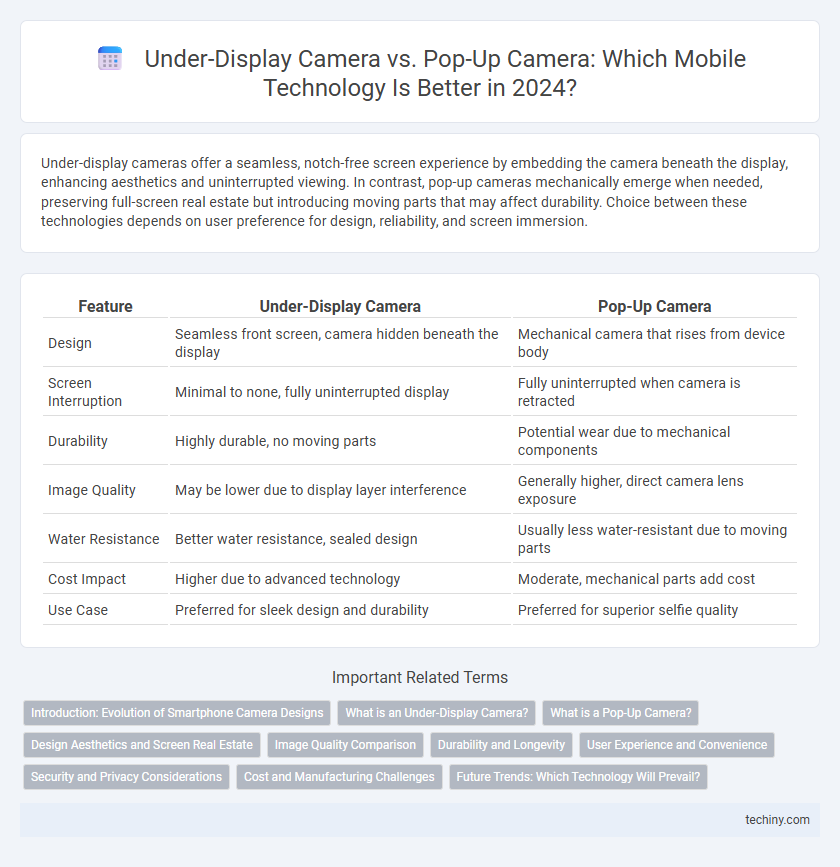Under-display cameras offer a seamless, notch-free screen experience by embedding the camera beneath the display, enhancing aesthetics and uninterrupted viewing. In contrast, pop-up cameras mechanically emerge when needed, preserving full-screen real estate but introducing moving parts that may affect durability. Choice between these technologies depends on user preference for design, reliability, and screen immersion.
Table of Comparison
| Feature | Under-Display Camera | Pop-Up Camera |
|---|---|---|
| Design | Seamless front screen, camera hidden beneath the display | Mechanical camera that rises from device body |
| Screen Interruption | Minimal to none, fully uninterrupted display | Fully uninterrupted when camera is retracted |
| Durability | Highly durable, no moving parts | Potential wear due to mechanical components |
| Image Quality | May be lower due to display layer interference | Generally higher, direct camera lens exposure |
| Water Resistance | Better water resistance, sealed design | Usually less water-resistant due to moving parts |
| Cost Impact | Higher due to advanced technology | Moderate, mechanical parts add cost |
| Use Case | Preferred for sleek design and durability | Preferred for superior selfie quality |
Introduction: Evolution of Smartphone Camera Designs
Under-display cameras represent a breakthrough in mobile technology by embedding the lens beneath the screen, enabling a seamless display without interruptions. Pop-up cameras emerged as an innovative solution to maximize screen-to-body ratio by mechanically extending the camera only when needed. Both designs reflect the evolution of smartphone camera technology aimed at enhancing user experience through improved aesthetics and functionality.
What is an Under-Display Camera?
An under-display camera is an innovative mobile technology that places the front-facing camera beneath the smartphone's display, enabling a full-screen experience without notches or punch holes. This technology uses a transparent OLED display area that allows light to pass through to the camera sensor, maintaining image quality while preserving the device's aesthetic. Under-display cameras offer seamless integration, enhancing screen-to-body ratio and providing a more immersive viewing experience compared to traditional pop-up cameras.
What is a Pop-Up Camera?
A pop-up camera is a mobile phone camera mechanism that physically extends from the device's body when activated, allowing for a full-screen display without a notch or punch-hole. This mechanical component typically uses a small motor or spring to elevate the camera module, retracting it when not in use to protect the lens and maintain the phone's sleek design. Pop-up cameras enhance user experience by providing an immersive viewing area while offering functional front-facing photography capabilities.
Design Aesthetics and Screen Real Estate
Under-display cameras offer a sleek design aesthetic by seamlessly integrating the camera beneath the screen, resulting in uninterrupted, full-screen displays that enhance the user's visual experience. Pop-up cameras, while maintaining a notch-free screen, introduce mechanical components that may affect durability and add thickness to the device. The under-display camera maximizes screen real estate more effectively by eliminating any camera intrusion, providing edge-to-edge displays favored in modern mobile technology design.
Image Quality Comparison
Under-display cameras often struggle with reduced image clarity and light distortion due to the screen's interference, resulting in less sharp and lower contrast photos compared to pop-up cameras. Pop-up cameras maintain traditional lens exposure, delivering superior image quality with better color accuracy and low-light performance. Smartphone models with pop-up cameras consistently achieve higher benchmark scores in camera tests, emphasizing their advantage in image fidelity.
Durability and Longevity
Under-display cameras offer enhanced durability by eliminating moving parts that are prone to wear and tear, unlike pop-up cameras which feature mechanical components susceptible to damage from daily use. Pop-up cameras may face longevity issues due to their motorized mechanism, increasing the risk of malfunction over time. Advances in under-display camera technology improve device lifespan by maintaining a seamless front surface free from mechanical failures.
User Experience and Convenience
Under-display cameras offer a seamless viewing experience by eliminating notches and pop-ups, resulting in a flawless full-screen display that enhances media consumption and gaming. Pop-up cameras provide higher image quality with dedicated sensors while maintaining an uninterrupted screen but introduce mechanical parts that may affect durability and speed. User convenience favors under-display cameras for everyday use due to their durability and instant availability, whereas pop-up cameras appeal to users prioritizing selfie performance despite slower activation times.
Security and Privacy Considerations
Under-display cameras offer enhanced security by minimizing physical moving parts, reducing the risk of mechanical failure and unauthorized access compared to pop-up cameras. Pop-up cameras, while physically hidden when not in use, can be more vulnerable to hacking due to their mechanical nature and potential software exploits during activation. Both technologies require robust encryption and software safeguards to protect user privacy, but under-display cameras tend to provide a more seamless and secure integration within mobile devices.
Cost and Manufacturing Challenges
Under-display cameras present higher manufacturing complexity due to the need for transparent OLED panels and advanced image processing algorithms, driving up production costs compared to pop-up cameras. Pop-up cameras rely on mechanical components that increase the risk of wear and failure but are generally less expensive to produce than under-display technology. The cost-effectiveness of pop-up cameras appeals to mid-range devices, while under-display cameras target premium segments despite the manufacturing challenges involved.
Future Trends: Which Technology Will Prevail?
Under-display camera technology is expected to dominate future smartphone designs due to its seamless integration and improved user experience without mechanical parts, enhancing screen-to-body ratios and durability. Pop-up cameras, while innovative with their motorized mechanisms, face challenges related to long-term reliability and waterproofing. Advances in under-display sensor transparency and image processing algorithms suggest a near future where this technology surpasses pop-up cameras in both functionality and aesthetic appeal.
Under-Display Camera vs Pop-Up Camera Infographic

 techiny.com
techiny.com